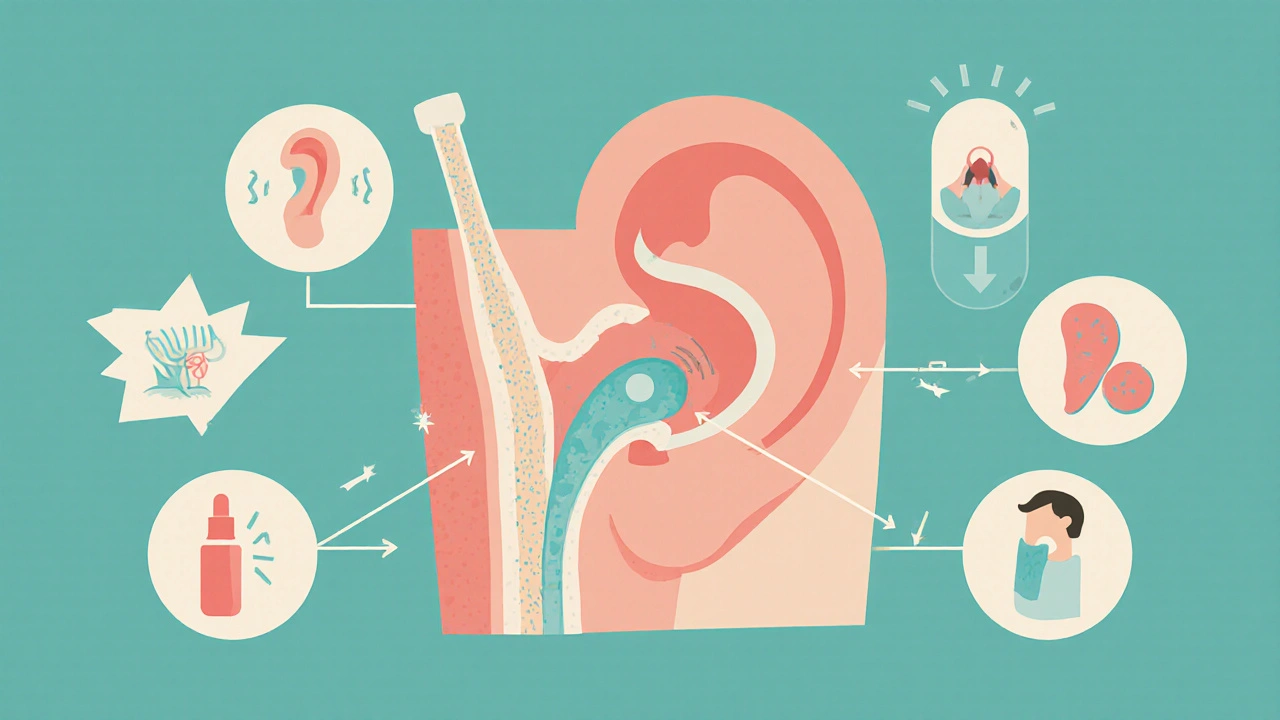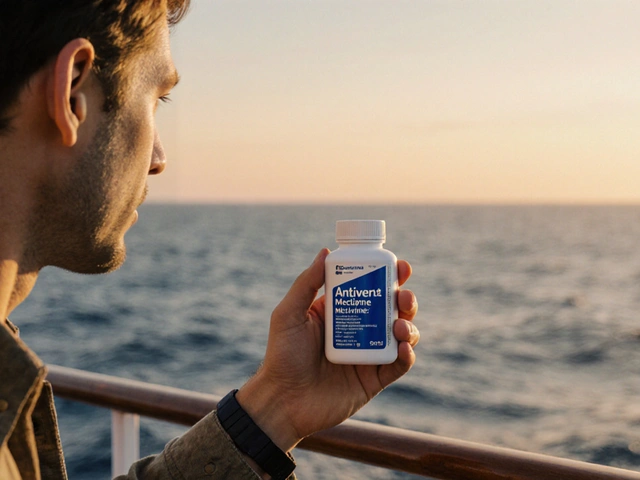
Flights can be a nightmare if your ears hurt. You’re not alone. Whether you’re flying with a toddler, dealing with a cold, or just have naturally stubborn Eustachian tubes, the drop in pressure during descent can feel like someone’s squeezing your eardrums. This isn’t just discomfort-it’s airplane ear, or barotrauma, and it affects nearly 1 in 5 adults and more than 1 in 4 kids during flights. The good news? You can stop it before it starts.
Why Your Ears Hurt During Flights
Your middle ear is a small air pocket behind the eardrum. Normally, it stays balanced with outside air pressure thanks to the Eustachian tube-a tiny 35mm channel that connects your ear to the back of your throat. When the plane climbs, pressure drops slowly. Your ears usually adjust fine. But when the plane descends, pressure builds fast. If your Eustachian tube doesn’t open quickly enough, your eardrum gets pulled inward. That’s when pain, muffled hearing, or even ringing kicks in. The pressure difference can hit 40 mmHg during rapid descents. That’s like diving 1.5 feet underwater without equalizing. Kids are worse off because their tubes are shorter (just 17mm), more horizontal, and less likely to open on their own. Adults with allergies, colds, or sinus congestion? Even worse. Swollen tissues block the tube entirely.What Actually Works: Equalization Techniques Ranked
Not all methods are created equal. Some are safe, some are risky, and some are just myths. Here’s what the data says:- Swallowing or yawning - Safe for everyone. Works 65% of the time. Do it constantly during descent. No effort needed. Just sip water, chew gum, or suck on hard candy.
- Toynbee maneuver - Pinch your nose, swallow. Success rate: 68%. Safer than blowing. Great for kids who can’t blow properly. Try it with a bottle or sippy cup-swallowing is stronger when they’re drinking.
- Lowry technique - Combine swallowing and gentle blowing at the same time. 89% effective for those who practice. Hard to master on the first try. Requires coordination.
- Valsalva maneuver - Pinch nose, blow gently. Works 82% of the time. But here’s the catch: if you blow too hard, you risk rupturing your eardrum or damaging your inner ear. Only use this if other methods fail, and blow like you’re trying to fog up a mirror-not like you’re inflating a tire.
- Voluntary Tubal Opening - Tense the soft palate, push jaw forward. 92% effective for trained users. Sounds crazy, but it works. Takes weeks to learn. Not practical for occasional flyers.
Filtered Earplugs: A Game Changer for Many
EarPlanes are the most popular filtered earplugs on the market. They’re not magic-they’re science. Inside is a ceramic filter that slows down pressure changes by 37%. That gives your Eustachian tube 28 extra seconds to catch up instead of 15. In controlled trials, they worked for 76% of users. For people with mild congestion or occasional issues, they’re a no-brainer. Cost? About $5 a pair. Reusable for 10+ flights. But here’s the catch: if you have chronic Eustachian tube dysfunction, they drop to just 42% effectiveness. They’re not a cure. Just a buffer.Decongestants: Use With Caution
Nasal sprays like Afrin (oxymetazoline) shrink swollen tissues in 10 minutes. Oral Sudafed (pseudoephedrine) lasts 8-12 hours. Both improve equalization success to 85% when taken 30-60 minutes before descent. But there’s a dark side. Sudafed can raise blood pressure and heart rate. The FDA warns against it for adults over 40 with heart conditions. About 12% of older users report palpitations. And for kids under 6? Never use oral decongestants. There are documented cases of dangerous fast heart rates. Nasal steroid sprays like Fluticasone (Flonase) are safer long-term. New research shows they reduce Eustachian tube inflammation by 61% when used daily for 5 days before flying. No heart risks. Just slower to work. Best for frequent flyers with allergies.
What to Do During Descent: The Real-Time Strategy
Don’t wait until your ears scream. Start early. Cabin pressure begins changing sharply around 8,000 feet. That’s when you should begin equalizing.- Start swallowing every 300-500 feet of descent. That’s about every 2-3 minutes.
- Use EarPlanes from boarding until the plane hits the ground.
- For kids: Offer a bottle, sippy cup, or pacifier during descent. Swallowing is 43% more effective than sipping from a cup.
- Try the jaw wiggle: Move your jaw side to side while swallowing. It helps kids and adults alike.
- If you’re sleeping, set an alarm. 73% of pediatric ear pain cases happen because parents let kids sleep through descent.
What NOT to Do
Most people make the same mistakes:- Waiting until it hurts. By then, it’s too late. Your eardrum is already stressed.
- Blowing too hard during Valsalva. That’s how 41% of inner ear injuries happen.
- Using decongestants if you have high blood pressure, heart disease, or are pregnant.
- Assuming earplugs will fix everything. They don’t work if your tubes are completely blocked.
- Trying new methods mid-flight. Practice swallowing techniques at home first.
Long-Term Solutions for Chronic Problems
If this happens every single flight, you’re not just unlucky-you might have chronic Eustachian tube dysfunction. It’s more common than you think. The FDA approved the Otovent device in 2022. It’s a nasal balloon you inflate through one nostril. It gently pushes air into the Eustachian tube. Clinical trials show 88% success. Works for adults and kids over 5. For severe cases, balloon dilation is now an outpatient procedure. A tiny balloon is inserted into the Eustachian tube and inflated for 2 minutes. It stretches the tube open. Success rate? 76% long-term. Costs $3,800-$5,200 out-of-pocket in the U.S. Even better? Mayo Clinic’s phase 2 trials for Eustachian tube stents show 92% success. These tiny implants keep the tube open. Still experimental, but coming fast.
What Airlines Are Doing to Help
You’re not just fighting your body-you’re fighting outdated aircraft design. Most planes keep cabin pressure at 8,000 feet. That’s like living in Denver. Newer planes like the Boeing 787 maintain 6,000 feet. That’s 25% less pressure difference. Delta Airlines now flies slower descents-3-degree angles instead of 3.5. That cuts pressure change rates by 14%. Airlines are also training flight crews to remind passengers to equalize. By 2025, the FAA may require all new aircraft to keep cabin altitude below 6,500 feet during descent. That’s huge.Final Checklist: Fly Without Pain
- 2-5 days before flight: Use nasal steroid spray daily (Flonase, Nasacort)
- Day of flight: Take decongestant only if no heart issues, 60 minutes before descent
- Boarding: Insert EarPlanes
- During descent: Swallow every 2-3 minutes. Chew gum. Sip water. Wiggle jaw.
- For kids: Bottle or pacifier during descent. No sleeping!
- Never force Valsalva. If it hurts, stop.
Most people who follow this routine report zero ear pain. It’s not about luck. It’s about timing, technique, and preparation. Your ears aren’t broken. They just need a little help.
Can airplane ear cause permanent hearing loss?
In rare cases, yes-less than 0.02% of flights. Permanent damage happens only if the eardrum ruptures and doesn’t heal, or if inner ear structures are damaged by forceful equalization. Most cases are temporary, with hearing returning within hours or days. But repeated episodes without treatment can lead to chronic issues like fluid buildup or Eustachian tube dysfunction.
Is it safe to fly with an ear infection?
It’s risky. An active ear infection means your Eustachian tube is already inflamed and blocked. Flying can turn mild discomfort into a ruptured eardrum. ENT doctors strongly advise delaying flights if you have pus, fever, or severe pain. If you must fly, use nasal steroids and EarPlanes, and avoid decongestants if you’re on antibiotics. Talk to your doctor first.
Why do children have more ear pain than adults on planes?
Kids’ Eustachian tubes are shorter, narrower, and more horizontal-making them harder to open. They also don’t swallow as often or as forcefully. Plus, they’re more likely to sleep through descent. Bottle-feeding during landing helps because sucking creates stronger swallowing pressure than sipping. Always keep kids awake and active during descent.
Do antihistamines help with airplane ear?
Only if allergies are the cause. Antihistamines like Claritin or Zyrtec reduce mucus production and swelling from allergies, which can help the Eustachian tube open. But they don’t work for colds or sinus infections. For congestion from illness, decongestants are better. For allergies, antihistamines + nasal steroids are the combo to use.
Can I use ear drops before flying?
No. Ear drops don’t reach the middle ear-they only affect the outer ear canal. They won’t help with pressure differences. In fact, some drops can worsen symptoms if you have a perforated eardrum. Focus on methods that open the Eustachian tube from the inside: swallowing, yawning, nasal sprays, or balloon devices.
How long does airplane ear last after landing?
Most cases resolve within a few hours. If your ears feel blocked or muffled for more than 24 hours, or if you have dizziness, ringing, or pain after landing, see a doctor. Persistent symptoms could mean fluid is trapped behind the eardrum, which might need treatment with nasal steroids or, rarely, a minor procedure to drain it.
Next Steps if Nothing Works
If you’ve tried everything-swallowing, earplugs, decongestants, steroids-and your ears still hurt on every flight, it’s time to see an ENT specialist. Chronic Eustachian tube dysfunction is treatable. Options include:- Balloon dilation (outpatient, 15-minute procedure)
- Eustachian tube stents (experimental but promising)
- Pressure equalization tubes (tympanostomy tubes) - rare for adults, common in kids
Don’t accept pain as normal. Your ears are designed to handle pressure changes. You just need to help them do their job.






jim cerqua
November 21, 2025 AT 17:30 PM
Okay so I flew last week with a full-on sinus infection and thought I was a god for popping decongestants like Skittles. Guess what? My eardrum felt like it was being slowly peeled off by a drunk raccoon during descent. I didn’t blow hard-I swear-but still, the pain was nuclear. Now I’m convinced the FAA is just waiting for us to crack so they can sell us ear stents on Amazon. I’m not mad… I’m just disappointed in humanity.
Also, why is no one talking about how airlines still fly like it’s 1987? Boeing 787s exist. Why am I breathing air that’s equivalent to Denver’s worst hangover? Someone get a lawyer.
And EarPlanes? I bought them. They did NOTHING. I felt like a sucker. Like I paid $10 for a plastic charm.
Also, my kid slept through descent. I didn’t. I’m now a widower of sanity.
TL;DR: Flying is a government-sanctioned torture chamber with free pretzels.